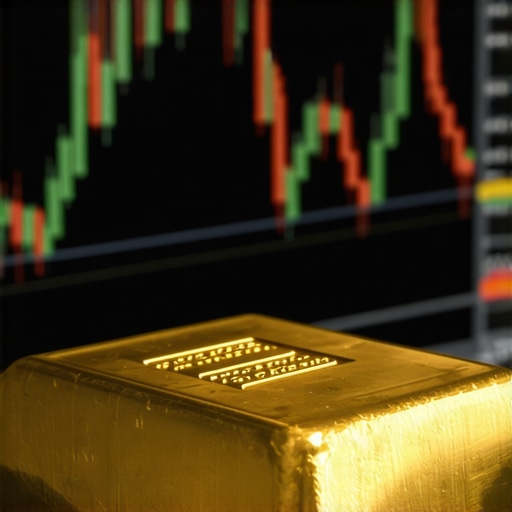The Current Landscape of Gold Prices: An Overview
As we navigate the complexities of the financial market, one question looms large for investors: is now the right time to buy gold? With its historical significance as a safe haven asset, gold continues to attract attention amidst economic fluctuations. Understanding current gold price trends is essential for making informed investment decisions. In this article, we will analyze the factors influencing gold prices and explore the potential implications for investors.
Why Gold Remains a Crucial Investment
Gold has long been seen as a reliable store of value, particularly in times of economic uncertainty. Its intrinsic value, coupled with its ability to hedge against inflation and currency fluctuations, makes it a preferred choice for many investors. In recent years, we have witnessed a surge in interest towards gold investments, leading to increased demand in both physical and paper gold markets.
Factors Influencing Gold Prices
Several key factors contribute to the fluctuation of gold prices:
- Global Economic Indicators: Economic data such as GDP growth, unemployment rates, and consumer confidence play a significant role in shaping gold prices. When economic conditions weaken, demand for gold typically increases as investors seek stability.
- Inflation Rates: High inflation erodes purchasing power, prompting investors to turn to gold as a hedge. As inflation expectations rise, so does demand for gold, which can drive prices higher.
- Central Bank Policies: Central banks around the world hold substantial gold reserves. Their policies on gold purchases or sales can significantly impact market dynamics. For instance, when central banks increase their gold reserves, it often leads to rising prices.
- Geopolitical Tensions: Events such as political instability, trade disputes, and military conflicts can create uncertainty in the market, prompting investors to flock to gold as a safer alternative.
Current Trends and Predictions
Recent analyses indicate that gold prices have experienced volatility due to a combination of the factors mentioned above. For instance, as inflation concerns rise and geopolitical tensions persist, gold has shown resilience, maintaining its status as a safe haven asset. Experts predict that in the coming months, gold may continue to be a strong investment choice, particularly as uncertainties loom over global economic recovery.
In conclusion, understanding current gold price trends is vital for those considering an investment in this precious metal. With its historical performance and role as a hedge against economic instability, gold remains a compelling option for investors. For further insights, consider exploring gold price forecasts and the current trends influencing the market. Investing wisely in gold can lead to significant benefits, especially when aligned with market conditions.
Investment Strategies for Gold in 2025
As we look ahead to 2025, developing effective investment strategies for gold is crucial for maximizing returns. Investors must consider various approaches tailored to their financial goals and market conditions. From physical gold to ETFs, understanding the nuances of each option can enhance your investment portfolio.
Types of Gold Investments to Consider
Several key types of gold investments are worth exploring:
- Physical Gold: Investing in physical gold, such as coins and bars, provides a tangible asset that can be stored securely. This method appeals to those who prefer direct ownership and the potential for long-term value appreciation.
- Gold ETFs: Gold exchange-traded funds (ETFs) offer a convenient way to invest in gold without the need for physical storage. These funds track the price of gold and can be bought and sold on stock exchanges, making them accessible for various investors.
- Gold Mutual Funds: These funds pool money from multiple investors to purchase a diversified portfolio of gold-related assets. They provide an indirect way to benefit from gold price fluctuations while reducing individual risk.
How to Choose the Right Investment Strategy
When selecting an investment strategy, consider the following factors:
- Risk Tolerance: Assess your risk appetite before diving into gold investments. Physical gold may be less volatile, while ETFs and mutual funds can offer higher potential returns with increased risk.
- Market Conditions: Stay informed about current market trends and gold price forecasts, as they can significantly influence your investment decisions.
- Investment Horizon: Determine your investment timeline. Long-term investors may prefer physical gold or mutual funds, while short-term traders might find ETFs more suitable for quick transactions.
The Role of Gold in Diversifying Your Portfolio
Gold’s unique characteristics make it a vital component of a diversified investment portfolio. As a non-correlated asset, it often behaves differently than stocks and bonds, providing a buffer against market volatility.
Benefits of Including Gold in Your Investment Mix
Incorporating gold into your investment strategy offers several benefits:
- Hedge Against Inflation: Gold has historically maintained its value during inflationary periods, making it an effective hedge. As inflation rates rise, gold can help preserve purchasing power.
- Safe-Haven Asset: In times of economic uncertainty or geopolitical tensions, investors tend to flock to gold, driving its value up. This safe-haven status can protect your portfolio during market downturns.
- Long-Term Stability: Over the long run, gold has shown consistent appreciation, providing capital gains for investors. Understanding gold price forecasts can further aid in making informed decisions.
Evaluating Gold Demand Trends for Future Investments
To make the most of your gold investments, it’s essential to stay updated on gold demand trends. Factors such as consumer demand, industrial usage, and investment trends can influence market dynamics. Analyzing these trends helps investors anticipate price movements and adjust their strategies accordingly.
In conclusion, understanding gold investment trends and strategies is fundamental for any investor looking to navigate the complexities of the market effectively. By considering different types of investments, risk factors, and current trends, you can make informed decisions that align with your financial goals. For more insights, explore beginner’s guides and advanced strategies for gold investment.
Analyzing Gold Price Trends for Effective Investment
Understanding gold price trends is critical for any investor aiming to maximize returns. Historical price movements often provide insights into future fluctuations, allowing investors to make informed decisions. Keeping an eye on factors that influence gold prices, such as macroeconomic indicators and geopolitical events, can significantly enhance your investment strategy.
Key Factors Influencing Gold Prices
Several factors can cause gold prices to rise or fall:
- Inflation Rates: As inflation rises, gold often gains value as it is viewed as a hedge against eroding purchasing power. Investors should monitor inflation forecasts to anticipate potential price increases.
- Interest Rates: Generally, lower interest rates make gold more attractive since it does not yield interest. Conversely, rising rates can lead to a decrease in gold demand, impacting prices.
- Geopolitical Stability: Political unrest and uncertainty often drive investors towards safe-haven assets like gold. Keeping abreast of global events can help predict price movements.
Strategies for Gold Trading in Bull Markets
When investing in gold, particularly in a bull market, employing effective trading strategies can enhance your returns. Here are some key strategies to consider:
- Timing the Market: Understanding market cycles and timing your entry and exit points can maximize gains. Utilizing technical analysis tools can aid in identifying ideal trading opportunities.
- Diversifying Your Gold Holdings: Consider diversifying your investments across various gold assets, including coins, bars, ETFs, and mutual funds. This approach mitigates risk and allows you to capitalize on different market segments.
- Using Derivatives for Leverage: For more experienced investors, trading gold futures or options can provide leverage, enabling greater exposure to price movements with a smaller capital outlay.
Understanding Gold ETFs and Their Benefits
Gold exchange-traded funds (ETFs) are an excellent option for investors seeking liquidity and diversification. These funds track the price of gold and can be traded on stock exchanges like regular stocks. The benefits of investing in gold ETFs include:
- Low Management Fees: Compared to mutual funds, gold ETFs typically have lower expense ratios, making them a cost-effective choice for investors.
- Flexibility: Investors can easily buy or sell shares throughout the trading day, allowing for quick adjustments to their investment strategy.
- Accessibility: Gold ETFs provide exposure to gold without the need for physical storage, making it easier for investors to incorporate gold into their portfolios.
Future Trends in Gold Investment
As we move towards 2025, several trends are shaping the future of gold investment:
- Increased Demand from Emerging Markets: Countries like India and China continue to show strong demand for gold, particularly in jewelry and investment forms. This trend can drive up prices and present opportunities for investors.
- Technology and Gold Investment: The rise of fintech solutions is making gold investment more accessible. Digital platforms that allow fractional ownership of gold are emerging, catering to younger investors.
- Sustainability Considerations: As investors become more environmentally conscious, the demand for sustainably sourced gold is likely to rise, leading to new investment products and opportunities in the gold market.
In summary, by staying informed about gold price trends, employing effective trading strategies, and understanding emerging market dynamics, investors can position themselves for success in the evolving landscape of gold investment. For more detailed insights, visit current gold market analysis to refine your investment approach.
Emerging Trends in Gold Investment: Insights for 2025
As we approach 2025, understanding the emerging trends in gold investment is essential for any savvy investor. With shifting market dynamics and evolving consumer behaviors, staying ahead of the curve can provide significant advantages. Here are some key developments that are shaping the future of gold investments.
The Role of Digital Gold Investments
Digital gold has emerged as a significant player in the investment landscape. This modern investment vehicle allows investors to buy and hold gold in digital form, often with the backing of physical gold stored in secure vaults. The advantages of digital gold include:
- Fractional Ownership: Investors can purchase small amounts of gold, making it accessible for those who may not have the capital for full ounces or bars.
- Convenience: Digital platforms facilitate easy transactions, allowing users to buy, sell, or trade gold at their convenience.
- Transparency: Most digital gold services provide real-time tracking of gold prices and holdings, enhancing investor confidence.
Shifts in Consumer Preferences Towards Sustainable Gold
As sustainability gains traction globally, investors are increasingly favoring ethically sourced gold. This shift is not just a trend but a necessity for many consumers who are conscious of the environmental and social impacts of their investments. Companies that prioritize sustainable practices are likely to attract more investors, making this a pivotal area for growth. Understanding the landscape of sustainable gold investments will be crucial for investors looking to align their portfolios with their values.
Gold as a Hedge Against Economic Uncertainty
Gold’s historical reputation as a safe-haven asset during times of economic uncertainty continues to hold true. Recent global economic conditions, marked by inflation fears and geopolitical tensions, have reaffirmed gold’s role as a stabilizer in investment portfolios. Investors should consider the following aspects:
- Market Volatility: Gold tends to retain its value when stock markets experience turbulence, making it an essential component of a diversified portfolio.
- Inflation Hedge: With rising inflation rates, gold often appreciates in value, serving as a protective measure against the diminishing purchasing power of currency.
- Geopolitical Tensions: Events such as conflicts or political instability can drive demand for gold, reinforcing its status as a secure investment option.
Technological Innovations in Gold Trading
The gold trading landscape is evolving thanks to technological advancements. Blockchain technology and AI-driven trading platforms are making gold trading more efficient and secure. Investors can benefit from:
- Enhanced Security: Blockchain technology provides a secure, decentralized method for trading gold, reducing the risk of fraud.
- Improved Liquidity: Faster transaction times and automated trading can increase liquidity, making it easier to enter and exit positions.
- Data-Driven Insights: AI tools can analyze market trends and provide predictive analytics, helping investors make informed decisions.
Conclusion: Preparing for the Future of Gold Investment
As the gold market continues to evolve, staying informed about these emerging trends can empower investors to make strategic decisions. By understanding digital gold, sustainable practices, and the impact of technology on trading, investors can position themselves advantageously in the gold investment landscape. For further insights, consider exploring current trends and predictions to refine your investment strategy.
Frequently Asked Questions about Gold Investment
What are the key benefits of investing in gold?
Investing in gold offers several benefits, including serving as a hedge against inflation, providing portfolio diversification, and acting as a safe-haven asset during times of economic uncertainty. Gold maintains its value better than other assets in turbulent markets, making it an appealing choice for investors seeking stability.
How does digital gold work?
Digital gold allows investors to buy and hold gold in a digital format, often linked to physical gold stored in secure vaults. This investment method provides fractional ownership, making it accessible to a broader audience, and offers the convenience of buying, selling, and tracking gold through digital platforms.
Why is sustainable gold investment gaining popularity?
Sustainable gold investment is becoming increasingly popular due to growing consumer awareness of ethical sourcing and environmental impact. Investors are drawn to companies that prioritize sustainable practices, making it essential for those looking to align their portfolios with their values.
How can one assess the quality of gold investments?
To assess the quality of gold investments, consider factors such as the purity of the gold (measured in karats), the reputation of the issuer or dealer, and any certifications that verify the gold’s authenticity. Researching market trends and historical performance can also provide insights into the potential value of the investment.
What role does technology play in gold trading?
Technology, particularly blockchain and AI, is revolutionizing gold trading by increasing security, enhancing liquidity, and providing data-driven insights. These advancements allow for faster transactions and reduce the risk of fraud, making gold trading more efficient for investors.
Can gold be part of a retirement strategy?
Yes, gold can be an integral part of a retirement strategy. As a stable asset, gold can help protect against inflation and market volatility. Many investors include gold in their retirement portfolios through gold IRAs or by holding physical gold as part of their overall asset allocation.
What are the risks associated with investing in gold?
While gold can be a safe investment, it is not without risks. Price fluctuations can occur due to market demand, economic factors, and geopolitical events. Additionally, storage and insurance costs for physical gold can impact overall returns, and investors should be aware of the potential for lower liquidity compared to traditional stocks and bonds.
How can I start investing in gold?
To start investing in gold, research different investment options such as physical gold (coins or bars), gold ETFs, or digital gold platforms. It’s crucial to determine your investment goals and risk tolerance before choosing the right method. Consulting with a financial advisor can also help you make informed decisions.
Is gold investment suitable for everyone?
Gold investment may not be suitable for everyone, as it depends on individual financial goals, risk tolerance, and investment strategy. While it can provide stability and diversification, investors should evaluate their overall portfolio and consult with financial professionals to determine if gold aligns with their objectives.
Authority Resources for Gold Investment Insights
For those looking to deepen their understanding of gold investment and stay updated on market trends, the following resources are highly recommended:
- World Gold Council – A leading authority on gold investment and market trends.
- Investopedia – Comprehensive articles and guides on gold investing and financial literacy.
- Kitco – Real-time gold market news, analysis, and insights.
- JM Bullion – Educational resources on buying and selling gold, along with market updates.
- BullionVault – A platform for buying, selling, and storing gold, with valuable market insights.
Conclusion: Embracing the Future of Gold Investment
As we look towards 2025 and beyond, the landscape of gold investment is transforming, driven by technological advancements, shifts in consumer behavior, and a renewed focus on sustainability. By understanding these emerging trends, investors can position themselves strategically within the gold market. Whether through digital gold, sustainable practices, or leveraging technology for smarter trading, the opportunities in gold investment are vast. Staying informed and proactive will be key to navigating this evolving market and achieving investment success.











The article does a great job outlining the key factors influencing gold prices, especially how geopolitical tensions and inflation concerns drive demand. From my experience keeping an eye on these elements, I’ve noticed how sudden political events often cause sharp, short-term spikes in gold prices before stabilizing again. What stands out to me is the critical role central bank policies play; their decisions to increase gold reserves can significantly sway market sentiment, often more than general economic indicators. I also find the discussion around investment strategies quite useful—deciding between physical gold and ETFs largely depends on one’s risk tolerance and investment horizon. Personally, I prefer a mix of physical gold and ETFs to balance liquidity and long-term security. Given the rising interest in digital gold and sustainable gold investments mentioned, it will be interesting to see how these trends influence price stability and investor access going forward. How are others approaching these emerging forms of gold investment, and what challenges or benefits have you encountered which might shape strategy in the near future?